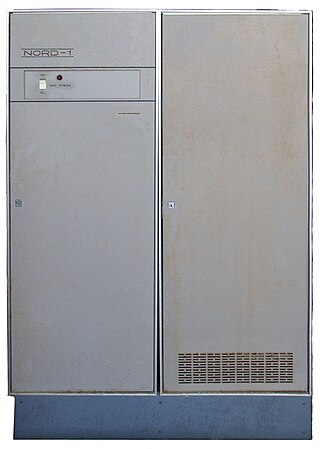
Lisp machines are general-purpose computers designed to efficiently run Lisp as their main software and programming language, usually via hardware support. They are an example of a high-level language computer architecture. In a sense, they were the first commercial single-user workstations. Despite being modest in number Lisp machines commercially pioneered many now-commonplace technologies, including effective garbage collection, laser printing, windowing systems, computer mice, high-resolution bit-mapped raster graphics, computer graphic rendering, and networking innovations such as Chaosnet. Several firms built and sold Lisp machines in the 1980s: Symbolics, Lisp Machines Incorporated, Texas Instruments, and Xerox. The operating systems were written in Lisp Machine Lisp, Interlisp (Xerox), and later partly in Common Lisp.

A minicomputer, or colloquially mini, is a type of smaller general-purpose computer developed in the mid-1960s and sold at a much lower price than mainframe and mid-size computers from IBM and its direct competitors. In a 1970 survey, The New York Times suggested a consensus definition of a minicomputer as a machine costing less than US$25,000, with an input-output device such as a teleprinter and at least four thousand words of memory, that is capable of running programs in a higher level language, such as Fortran or BASIC.
The 88000 is a RISC instruction set architecture developed by Motorola during the 1980s. The MC88100 arrived on the market in 1988, some two years after the competing SPARC and MIPS. Due to the late start and extensive delays releasing the second-generation MC88110, the m88k achieved very limited success outside of the MVME platform and embedded controller environments. When Motorola joined the AIM alliance in 1991 to develop the PowerPC, further development of the 88000 ended.

Data General Corporation was one of the first minicomputer firms of the late 1960s. Three of the four founders were former employees of Digital Equipment Corporation (DEC).

Dolphin Interconnect Solutions is a privately held manufacturer of high-speed data communication systems headquartered in Oslo, Norway and Woodsville, New Hampshire, USA.
Aviion was a series of computers from Data General that were the company's main product from the late 1980s until the company's server products were discontinued in 2001. Earlier Aviion models used the Motorola 88000 CPU, but later models moved to an all-Intel solution when Motorola stopped work on the 88000 in the early 1990s. Some versions of these later Intel-based machines ran Windows NT, while higher-end machines ran the company's flavor of Unix, DG/UX.
AT&T Computer Systems is the generic name for American Telephone & Telegraph's unsuccessful attempt to compete in the computer business. In return for divesting the local Bell Operating Companies, AT&T was allowed to have an unregulated division to sell computer hardware and software. The company made the 3B series computers.

Nord-10 was a medium-sized general-purpose 16-bit minicomputer designed for multilingual time-sharing applications and for real-time multi-program systems, produced by Norsk Data. It was introduced in 1973. The later follow up model, Nord-10/S, introduced in 1975, introduced CPU cache, paging, and other miscellaneous improvements.

Nord-1 was Norsk Data's first minicomputer and the first commercially available computer made in Norway.
Sintran III is a real-time, multitasking, multi-user operating system used with Norsk Data minicomputers from 1974. Unlike its predecessors Sintran I and II, it was written entirely by Norsk Data, in Nord Programming Language, an intermediate language for Norsk Data computers.
The Nord-100 was a 16-bit minicomputer series made by Norsk Data, introduced in 1979. It shipped with the Sintran III operating system, and the architecture was based on, and backward compatible with, the Nord-10 line.

The ND-500 was a 32-bit superminicomputer delivered in 1981 by Norsk Data. It relied on a ND-100 to do housekeeping tasks and run the OS, SINTRAN III. A configuration could feature up to four ND-500 CPUs in a shared-memory configuration.
PLANC is a high-level programming language.
ND-NOTIS was a office automation suite by Norsk Data introduced in the early 80s, running on the SINTRAN III platform on both ND-100 and ND-500 architectures. It was also available on Microsoft Windows running in networks of Norsk Data servers.
ND-COSMOS was the proprietary computer networking system developed by Norsk Data as the second generation NORDNET system.
Nord Programming Language (NPL), is a procedural programming language by the Norwegian minicomputer manufacturer Norsk Data. It shipped as a standard component of the operating system Sintran III.

Norsk Data (ND) was a Norwegian manufacturer of minicomputers which operated between 1967 and 1992. The company was established as A/S Nordata – Norsk Data-Elektronikk on 7 July 1967 and took into use the Norsk Data brand in 1975. The company was founded by Lars Monrad-Krohn, Rolf Skår and Per Bjørge, three computer engineers working at the Norwegian Defence Research Establishment which had just built the minicomputer SAM 2. ND's first contract was the delivery of a Nord-1 computer to Norcontrol. Initially in competition with Kongsberg, ND started delivering computers to Norwegian institutions. By 1972 the company had developed Sintran operating system, the 32-bit Nord-5 and a time sharing system.
The Research and Development Network in Norway or FUNN was fourteen computing centers established in regional districts in Norway established by Norsk Data (ND) and the Ministry of Trade and Industry in 1989. These were located in Ålesund, Alta, Bø, Gjøvik, Grimstad, Kirkenes, Kristiansund, Mo i Rana, Narvik, Sarpsborg, Sogndal, Steinkjer, Stord and Tromsø. Each had two Norsk Data-built minicomputers, one running Sintran III and one running Unix. Participating agencies included the Regional Development Fund, the Ministry of Local Government and Regional Development, the Norwegian Telecommunications Administration (NTA) and the Royal Norwegian Council for Scientific and Industrial Research (NTNF).
Harris Computer Systems Corporation was an American computer company, in existence during the mid-1990s, that made real-time computing systems. Its products powered a variety of applications, including those for aerospace simulation, data acquisition and control, and signal processing. It was based in Fort Lauderdale, Florida. For twenty years prior, it had been the Harris Computer Systems Division of Harris Corporation, until being spun off as an independent company in 1994. Then in 1996, Harris Computer Systems Corporation itself was acquired by Concurrent Computer Corporation.









